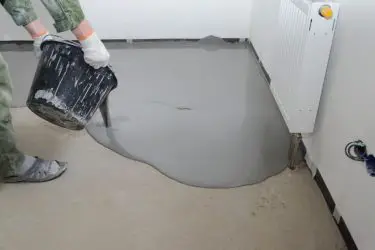Outdoor rugs have several clear benefits, whether functional or decorative. On the other hand, if you have a concrete patio or deck, you might worry: can an outdoor rug damage the concrete?
Outdoor rugs do not directly damage concrete. However, an improperly maintained and covered outdoor rug can trap water within and underneath its material, making it corrosive on a concrete surface. This effect will be more noticeable in an area with frequent rain.
In this article, I’ll give you a more thorough explanation of any possible damaging effects outdoor rugs can have on concrete, as well as how you can take steps to mitigate this damage.

Table of Contents
Can You Put Your Outdoor Rug on Concrete?
While an outdoor rug may exacerbate damage and water corrosion to concrete, this doesn’t necessarily mean that you should rule out an outdoor rug altogether.
You can put an outdoor rug on concrete. Frequent drying and cleaning can correct any water damage the rug might cause. In addition, covering the concrete with a durable and high-quality rug material can prolong the life of the concrete when you maintain it properly.
Let’s take a look at some of the steps you can take to properly use and maintain an outdoor rug for your concrete patio or deck.
Preventing Water Damage to Your Rug
One of the most basic methods to prevent an outdoor rug from potentially causing damage to concrete is by ensuring the fabric itself remains undamaged.
According to Consumer Reports, washing and drying your outdoor rug is the best way to protect it from decay. An uncleaned rug exposed to rainfall or severe weather can grow mold and mildew, leading to a deterioration of the rug’s fabric and structure.
You can effectively prevent water damage to your rug by storing it indoors when you see signs of rain approaching.
However, storing your rug is not always a realistic solution, as you likely won’t always have the time or availability to do so. In these cases, hanging it over a fence to dry or keeping it on a porch when the bad weather hits are also suitable options.
Using a Rug on an Uncovered Patio
While covering your outdoor rug is the best way to protect it (and your concrete patio!) from damage, there are other highly effective damage control methods.
As explained by the Denver Post, one technique is to shake the rug vigorously if it’s recently dealt with bad weather.
If a quick shake isn’t enough to get the rug back into shape, prolonged hanging will often do the trick, especially if you’ve thoroughly cleaned the fabric first. This cleaning and hanging process is typically enough to expel excess water and prevent mildew from forming.
However, an uncovered rug will inevitably face damage from rain, heat, and other sources of decay.
As a result, if you regularly leave your outdoor rug exposed to the elements, you probably shouldn’t expect it to last more than a couple of years.

Types of Rugs To Use for a Concrete Patio
When it comes to protecting your concrete patio from damage, not all outdoor rugs are created equal.
For example, rugs made from polypropylene are more durable and resistant to weather than other types of outdoor rugs. This weather-resistant material typically means that these rugs will have a more extended use life and are less likely to worsen rain damage to your concrete patio.
Likewise, Home Depot specifies that rugs made from synthetic fibers will generally be more resistant to corrosive weather than natural materials.
However, if you’d like to use an outdoor rug made from natural fabric, that’s entirely fine! Just wash it carefully and frequently and, preferably, store it somewhere dry when a nasty rainstorm appears.
Maintaining an Outdoor Rug
As I suggested above, washing and drying your rug frequently can prevent damage to it. However, what’s the most effective way to do this?
Let’s take a look:
- Know if you can wash the rug. While you can clean some outdoor rugs, others might degrade when you scrub them, or they might be sensitive to certain cleaning chemicals. The manufacturer should provide details that will clear this up.
- Scrub the rug with a mix of soap and water. If you’re dealing with more sensitive material, it’s best to perform this process gently and use a gentle, carpet-cleaning soap (depending on the manufacturer’s instructions).
- After you’ve scrubbed the rug, you can hang it up to dry. For an outdoor carpet, shrinking should be no concern. The sunlight will also prevent fungi from growing on your rug, so be sure to put it out on a sunny day.
Repeating this process every month is ideal, but semi-frequently washing the rug can give you great results if limited time is a factor!
How Do You Protect Your Concrete Patio?
Now that I’ve helped you figure out how to best use an outdoor rug for your concrete deck or patio, you probably want to know what other steps you can take to protect the concrete from damage.
You can protect your concrete patio with sealing material, using external covering like a tree or gazebo, and regularly examining the concrete for existing damage. Ideally, it would be best to combine all these methods to keep the concrete undamaged.
Let me give a detailed walkthrough of each method so you can get a better idea of how to keep your concrete patio as safe as possible.
Seal Your Concrete Patio
Using a chemical sealer or paint should be the first line of defense to protect your concrete patio from the elements.
Property Owners Association of New Jersey explains that these paints and sealants keep water from invading concrete structures and oxidizing the material. This prevention is essential, as oxidation leads to concrete cracking, splitting, and decay.
I highly recommend using a sealant or paint that provides a moderate-to-high level of protection from chemical deterioration in your patio’s concrete.
Examples of the sealing supplies you’ll want to look at include latex paints and, for the most durable protection, epoxy sealers.
Cheaper paints and sealants may be acceptable if you expect damage to your concrete to be minimal. Still, if your patio encounters a great deal of moisture or cold temps, it’s best to be a bit cautious and go for the most protective options, even if they are a bit pricier.
Cover Outdoor Concrete
After chemical sealing, the next most effective step you can take is to waterproof your concrete patio with an outdoor covering.
While an artificial structure like a gazebo may be the most optimal choice, you don’t necessarily have to get that intense with the outdoor protection. If you live in a place with minimal rainfall and severe weather, a simple source of outdoor cover could be a tall tree.
Other possibly natural and artificial cover sources include:
- Shade cloth
- Pergolas
- Umbrellas
- Arches
Whichever cover you decide to go with, it’s crucial to check if it’s doing its job by regularly examining the concrete for cracks, decay, or other signs of damage.
Inspect Concrete for Damages
The final step to protecting your concrete patio is to inspect the deck for wear and tear carefully.
According to Buildings, concrete damage is often directly visible to the naked eye if you know what you’re supposed to notice.
For some common signs of moisture damage to your concrete patio, check to see if you notice any of the following:
- Cracking and splitting
- Uneven discoloration
- Mold and mildew
- White residue
- Black stains
Final Thoughts
Using an outdoor rug for a concrete walkway is entirely manageable. All it requires is a solid and durable, weather-resistant rug, along with frequent washing and drying to ensure the carpet lasts as long as possible.
For more direct protection of the concrete itself, several options are available.
As an initial precaution, sealing or painting the concrete to prevent moisture from slipping in is critical. You’ll want to continue this by protecting your patio with an outside cover and frequently inspecting it for damages.



